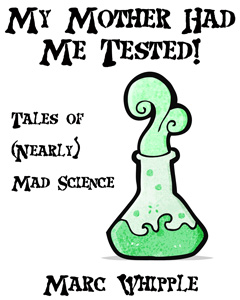So, first, to get it over with: I wrote a book. It’s called My Mother Had Me Tested! and it’s a collection of funny mad science/geek-related short stories. Please have a look. If you think you might enjoy it, please read the free sample. If you still think you might enjoy it, please buy it. Here’s the link: http://amzn.com/B00WFV3YZU
Okay? Okay.
Now that the plug is done – and I would never suggest that you should buy my book to make the rest of this post easier to follow, no way, not for a minute – I’m going to go over some of the potential legal issues involved with the publication of my book, My Mother Had Me Tested!. (Okay, I’ll stop now. From here on out it’s just MMHMT, and no more links. Promise. 
Also, please keep in mind that nothing in this post is intended to be legal advice. I am reviewing my own work and pointing out generally interesting issues regarding it. My goal is not to provide specific answers to legal questions, but show examples of how one might approach these issues, and help you to be more aware of the potential for liability which your own creative endeavors might create. Always consult an attorney licensed in your jurisdiction and familiar with the relevant law *ahem* before making legal decisions.
Okay? Okay.
On with the review!
ISSUE ONE: COVER ELEMENTS
This one’s easy. I licensed the cover illustration from an online stock photo company called CanStockPhoto. They have a required copyright disclaimer: I included it. The font I used I found online and, after review, I decided that my usage of it for this purpose was acceptable. (Digital font files, by the way, can be copyrighted. Generally speaking, type itself cannot.) There’s no visible person, actual or not, so I don’t have to worry about a likeness release. (More about use of likeness below.) If there were, I’d need one or need to make sure the person I licensed the photo from had one. Stock Photo sites usually make this clear – if it’s marked “editorial,” you probably shouldn’t use it for commercial purposes. If it’s not, it’s probably released, but you should still check. If you commission a cover photo or illustration, make sure your artist provides a likeness release as well as a copyright license if necessary.
Finally, I made the cover myself, so I didn’t have to worry about the copyright on the assembled elements. If I’d had an artist do it for me, I’d have needed a copyright license, but I didn’t, so I didn’t. Next question!
Continue reading In Which I Review My Own Book For Potential Legal Issues.
